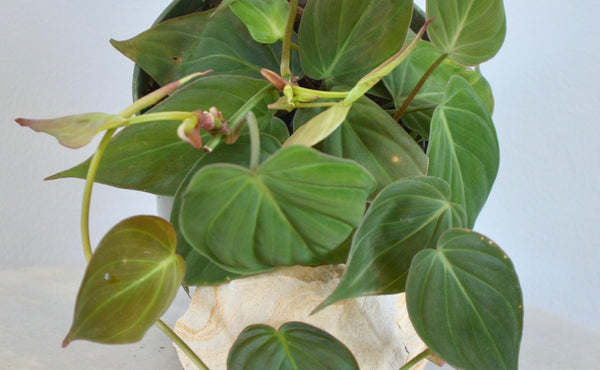Philodendron Micans: Complete Houseplant Guide

Making a grand comeback in the plant world, the Philodendron Micans is an unusual dark, velvety indoor plant. Once popular in the 1970-80’s, this Philodendron is experiencing a resurgence of interest due to the unique look and textured foliage. It’s a fairly easy plant to care for and is recommended to anyone from beginners to more advanced plant parents.
Scientific Name: Philodendron hederaceum var. hederaceum
Common Names: Philodendron Micans, Velvet Plant
Origin: Native from Mexico to South America

About
The Philodendron Micans is most likely understood to be a natural variation of the Philodendron hederaceum, aka the Heartleaf Philodendron. Due to a process called morphogenesis, plants can undergo natural changes that present as physical variations (i.e., shape, size, texture, color, etc.) as a result of exposure to different environmental conditions (i.e., levels of warmth, humidity, light, nutrients, etc). Native to tropical rainforest regions where it nestles in the understory level of the jungle. It’s classified as an epiphyte, which means that it has aerial roots that latch onto trees, allowing the plant to climb skywards. In the wild, this plant can reach 30 feet long with the leaves spanning to 8 inches. However, in indoor environments, the Micans can grow to about 10 feet (especially when given preferable conditions).
As a vining plant, the appearance is what really makes the Philodendron Micans special, with soft, iridescent, velvet-like foliage. New growth emerges as a burnt amber color that morphs into an emerald green and finally to a deep hunter green as the leaf matures. The undersides of the leaves are a dark purple.
The Micans, like many Philodendron plants, is low-maintenance and will thrive when provided basic requirements. We know that the natural habitat for the plant (tropical jungles) is warm and shaded by trees above. So likewise, the plant will enjoy similar conditions inside as a houseplant. Typically, indoor temperatures that are comfortable to you (let’s say between 70-80) are also ideal for your houseplants. Despite how favorable the conditions are though, this plant very rarely blooms in nature, so don’t expect it to flower outside of its natural habitat.

Indoor Care:
Sun
Again like most Philodendron species, this plant enjoys bright, indirect light. Windows that are east or west facing are typically the best for these lighting conditions. While the Philodendron Micans can grow in lower light environments, we recommend a moderate to bright spot for the plant to really thrive to its full potential. Always make sure to avoid direct sun ray exposure since too much light can fade or even burn the leaves.
Water
Micans prefer to be watered once the soil has partially dried (about halfway down the pot). Allowing the plant to dry out somewhat between waterings will prevent the instance of root rot while also avoiding underwatering. We typically suggest that when in doubt, underwater since this plant can handle missing a dose or two (and bounce back easily). If you do notice that your Micans is experiencing droopy, shriveled leaves, then that may be an indicator that your plant needs more water.
Repotting
Once your Philodendron Micans has started to outgrow the current pot– perhaps with roots reaching out of the bottom holes of the pot– then it’s likely time to pot it up a size. Keep in mind that it’s only necessary to repot when the plant absolutely needs it (and not just for the sake of repotting), since the practice can be slightly stressful for the plant. Typically, the Micans will want to be repotted about once every year or two. If your plant does need repotting, always use a very well-draining soil.

Fertilizer
A houseplant fertilizer will provide your plant with vital nutrients of phosphorus, nitrogen, and potassium to survive and flourish. During the active growing season of spring and summer, your Micans will need fertilizer. About once a month (note: always follow the specific fertilizer schedule), you’ll sprinkle or pour fertilizer on the top of the soil accordingly.
Unless you live in a temperate climate, cut back on fertilizer in the colder months of fall and winter.
Pests
While your run-of-the-mill houseplant pests (like thrips, mealybugs, or spidermites) can disturb your Philodendron, it’s really not a common occurrence with the Micans. Prevention is the best method when it comes to pests, so always check regularly for pest presence and treat if visible.
Toxicity
Calcium oxalate crystals are found in the structure of Philodendron plants. This substance is actually common in many household vegetables, but it’s advised to steer clear of contact with eyes or ingesting since it can be irritative to some.
Buy Online: Philodendron Micans— 6 Inch